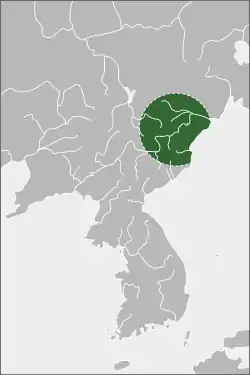Eastern Buyeo
Dongbuyeo was an ancient Korean kingdom that developed from Bukbuyeo, until it was conquered by early Goguryeo, which then grew into one of the Three Kingdoms of Korea. According to the Samguk Sagi, it was established when Buyeo's king Hae Buru (Korean: 해부루; Hanja: 解夫婁) moved the capital eastward by the sea.
Dongbuyeo 동부여(東夫餘) | |||||||||
|---|---|---|---|---|---|---|---|---|---|
| 2nd century BC–410 AD | |||||||||
 Map of Eastern Buyeo (3rd century) | |||||||||
| Capital | Gaseopwon | ||||||||
| Common languages | Buyeo language | ||||||||
| Government | Monarchy | ||||||||
| King | |||||||||
• ?–60 BC | Hae Buru (first) | ||||||||
• 60-20 BC | Hae Geumwa | ||||||||
• 20 BC–22 AD | Hae Daeso | ||||||||
• ?–68 AD | Hae Dodu | ||||||||
| Historical era | Ancient | ||||||||
• Established | 2nd century BC | ||||||||
• Disestablished | 410 AD | ||||||||
| |||||||||
| Today part of | China North Korea | ||||||||
| Dongbuyeo | |||||||
| Korean name | |||||||
|---|---|---|---|---|---|---|---|
| Hangul | |||||||
| Hanja | |||||||
| |||||||
Part of a series on the |
||||||||
|---|---|---|---|---|---|---|---|---|
| History of Korea | ||||||||
 | ||||||||
| Prehistoric period | ||||||||
| Ancient period | ||||||||
|
||||||||
| Proto–Three Kingdoms period | ||||||||
| Three Kingdoms period | ||||||||
|
||||||||
| Northern and Southern States period | ||||||||
|
||||||||
| Later Three Kingdoms period | ||||||||
|
||||||||
| Dynastic period | ||||||||
|
||||||||
| Colonial period | ||||||||
|
||||||||
| Modern period | ||||||||
|
||||||||
| Topics | ||||||||
| Timeline | ||||||||
Founding
According to the Samguk Sagi and other accounts, the kingdom of Dongbuyeo branched out to the east of Bukbuyeo, near the land of Okjeo.
Hae Buru found a golden frog-like child under a large rock. Hae Buru named the child Geumwa, meaning golden frog, and later made him crown prince.
Early Eastern Buyeo
Geumwa became king after Hae Buru's death. Not long after, King Geumwa reversed his father's submission to Bukbuyeo and declared himself "Supreme king" and gave the title posthumously to his father, Hae Buru. At Ubalsu, south of Taebaek Mountain, Geumwa met Lady Yuhwa (Korean: 유화부인; Hanja: 柳花夫人), who was the disowned daughter Habaek (Korean: 하백; Hanja: 河伯), the god of the Amnok River or, according to an alternative interpretation, the sun god Haebak (Korean: 해밝).[1][2][3][4] and brought her back to his palace. She was impregnated by sunlight and laid an egg, from which hatched Jumong (Korean: 주몽; Hanja: 朱蒙).[1]
Geumwa's two sons resented Jumong, and although Geumwa tried to protect him, Jumong ran away to Jolbon Buyeo, where he later established Goguryeo.
Geumwa's eldest son Daeso became the next King. King Daeso attacked Goguryeo during the reign of its second ruler, King Yuri. Goguryeo's third ruler King Daemusin attacked Dongbuyeo and killed King Daeso. After internal strife, Dongbuyeo fell, and its territory was absorbed into Goguryeo.
Later Eastern Buyeo
According to other records, Jumong was from Bukbuyeo, not Dongbuyeo. According to the Gwanggaeto stele, Dongbuyeo was a tributary of Goguryeo. Dongbuyeo was briefly revived by a small state established around 285 by refugees of Buyeo. This state was conquered by King Gwanggaeto the Great of Goguryeo in 410.
Although the chronology is inconsistent with the Samguk Sagi, one legend says Wutae, the father of the Baekje's founder and 1st ruler, Onjo, was a son of Hae Buru.
See also
- Buyeo kingdom
- Goguryeo
- List of rulers of Dongbuyeo
References
- Doosan Encyclopedia 유화부인 柳花夫人. Doosan Encyclopedia.
- Doosan Encyclopedia 하백 河伯. Doosan Encyclopedia.
- Encyclopedia of Korean Culture 하백 河伯. Encyclopedia of Korean Culture.
- 조현설. "유화부인". Encyclopedia of Korean Folk Culture. National Folk Museum of Korea. Retrieved 30 April 2018.